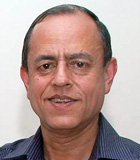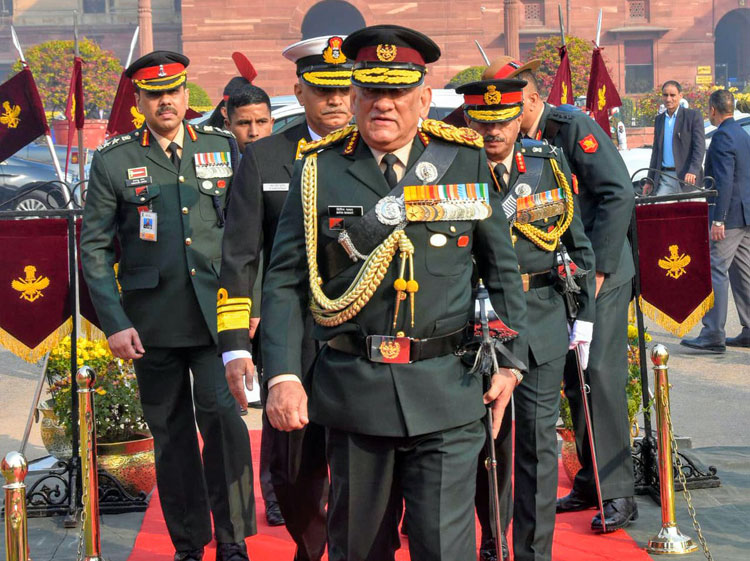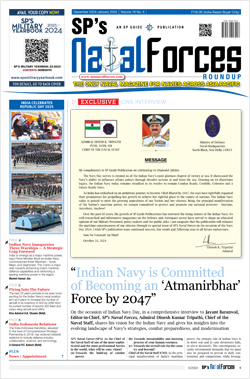INDIAN ARMED FORCES CHIEFS ON OUR RELENTLESS AND FOCUSED PUBLISHING EFFORTS

The insightful articles, inspiring narrations and analytical perspectives presented by the Editorial Team, establish an alluring connect with the reader. My compliments and best wishes to SP Guide Publications.

"Over the past 60 years, the growth of SP Guide Publications has mirrored the rising stature of Indian Navy. Its well-researched and informative magazines on Defence and Aerospace sector have served to shape an educated opinion of our military personnel, policy makers and the public alike. I wish SP's Publication team continued success, fair winds and following seas in all future endeavour!"

Since, its inception in 1964, SP Guide Publications has consistently demonstrated commitment to high-quality journalism in the aerospace and defence sectors, earning a well-deserved reputation as Asia's largest media house in this domain. I wish SP Guide Publications continued success in its pursuit of excellence.
- MoD initiates comprehensive review of Defence Acquisition Procedure 2020, pushes for defence reforms
- G7: The Swansong
- Kalinga Connect: South Asia to Polynesia
- Advanced MRSAM for India for a greater firepower
- Must Credit DRDO for Operation Sindoor, now what is next for defence R&D?
- Operation Sindoor | Day 2 DGMOs Briefing
- Operation Sindoor: Resolute yet Restrained
Structure of Department of Military Affairs (DMA)
 |
The Author is Former Director General of Information Systems and A Special Forces Veteran, Indian Army |

Structure of the newly established Department of Military Affairs (DMA) in the Ministry of Defence (MoD), with the Chief of Defence Staff (CDS) heading it as Secretary DMA, has come up with the news of its organisation released through the media in installments. Slated to have a mix of civil and military officials, first news emerged that a battery of bureaucrats from the Department of Defence (DoD) within MoD were being side-stepped to the DMA, and that two Joint Secretary's were also being posted to DMA. Then came news that DMA will have a Secretary, Transformation and Coordination which will be the Chief of Integrated Defence Staff (CIDS), an Additional Secretary and five Joint Secretaries (two from the IAS and three from the Military – one each from the Army, Navy and Air Force). Having three Joint Secretary's from the military in DMA is good although the noise that a uniformed Joint Secretary in MoD is happening for the first time is not true. Earlier there was a Joint Secretary post in the Ministry called JS MIL which was held by a two-star rank officer - Major General / equivalent.
The structure of DMA is likely to undergo more changes, which may take considerable time. DMA is presently working on interim organisation. News reports of February 14, 2020 have quoted Major General Mukesh Aggarwal, Advisor to CDS in saying, "At present, we have an interim structure. The approval has not come, so they have no financial powers. All files related to financial approvals are coming to the Secretary, DMA. We made a much leaner organisation as we have domain specialists. It has been agreed to in-principle but the approvals will take some time". At the same time Aggarwal was also quoted in saying that DMA had studied various models including the Ministry of External Affairs (MEA), the Indian Space Research Organisation (ISRO) and the Defence Research and Development Organisation before arriving at a suitable model, and that the proposed model is also an interim one and would be reviewed. How much time the powers that be would take to approve the proposed interim model followed by formulating the final model and getting it approved is anybody's guess.
This is typical of India's politico-bureaucratic functioning. Prime Minister Narendra Modi had announced establishment of the CDS on August 15, 2019, following which a Committee headed by the National Security Advisor, with Cabinet Secretary, Defence Secretary, Expenditure Secretary and the three Service Chiefs as members worked on the structure. Yet, we will continue struggling for a final structure over prolonged period of time. In contrast, the Goldwater-Nichols Act of October 4, 1986 in the US reorganised the US Department of Defense (DoD) completely and centralised military advice in the Chairman of the Joint Chiefs of Staff (JCS) who was designated as the Principal Military Advisor to the President. The structure of the JSC was fully worked out.
We could have similarly gone for a comprehensive Act of Parliament covering establishment of the CDS structure as well as transformation of the Indian Military rather than the above mentioned committee. This would have obviated the need to struggle with the required structure for long. We don't seem to have learnt from the experience in setting up the HQ Integrated Defence Staff (IDS) which too was established in a hurry in 2004. Within HQ IDS, the Defence Intelligence Agency (DIA) was well staffed but to stabilise other branches took time. In establishing the CDS and DMA, in accordance with the current charter issued by the government, big-ticket acquisitions (capital acquisitions) will remain under the Defence Secretary's purview and thus final negotiations with foreign collaborators / defence public sector undertakings (DPSUs) and Indian private industry rests with the DoD and the Defence Secretary. Delays as earlier are likely to remain and it is surprising that with 'Make in India' and 'Start-up India' though the Prime Minister's pet initiatives have not really taken off. Yet, the government is persisting in following the old structures. CDS is to deal with the three Services, HQ IDS, Territorial Army, Works relating to Services and procurements excluding capital acquisitions, promote inter-service jointness, besides being principal military advisor to Defence Minister.
As Permanent Chairman COSC (PC COSC), CDS to usher inter-service jointness (operations, logistics, transport, training, support services, communications, repairs and maintenance), prioritise capital acquisition and administer tri-service agencies with Cyber and Space Commands under him, besides being member of DAC and military adviser to the Nuclear Command authority (NCA). Though the DMA is within the MoD, it is more of a standalone with the CDS having limited powers because the Defence Secretary will continue to enjoy the nodal authority in MoD for all cases especially with policy during war, no-war and peace, as well as capital acquisitions under him. Many scholars are of the view that the CDS and DMA in their present shape are expected to deliver much more than what they have been empowered with. For example, the CDS is required to establish joint Theatre Commands within three years of first CDS having assumed appointment. This time-table defined by the NSA-headed committee itself is ridiculous. But though much is in the news including statements by the CDS about military transformation and plans for Theatre Commands, how are we going about these without having defined a National Security Strategy (NSS) and without undertaking a Strategic Defence Review (SDR)? Should we ignore the intrinsic link between policy and military transformation, going about the latter without clarity in policy?





